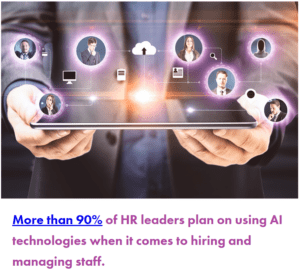Artificial intelligence has been a game-changer for human capital management in the realms of recruitment, retention, and employee satisfaction.
By Anjali Byce
Despite the fast-paced technological breakthroughs witnessed in recent years, employees very much remain the backbone of any organization.
Traditionally, HR teams haven’t had technological tools to gauge morale, assess productivity, hire staff, and ensure that their organizations’ most important resource—their people—have the support they need to thrive. But the advent of artificial intelligence (AI) now allows HR leaders to leverage advanced algorithms and analytics to gain better insights into the human element of their organization, leading to better decision-making; reduced bias and “groupthink” when it comes to hiring; implement real-time pulse checks to assess morale; and more.
The AI HR market is expected to grow by 35% in the next five years, from $3.9 billion in 2022 to $17.6 billion in 2027, and more than 90% of HR leaders plan on using it when it comes to hiring and managing staff. HR leaders should be considering implementing AI into many facets of human capital management.
Gauging Morale and Reducing Staff Turnover
Hiring new talent is one thing, but retaining talent long-term is a challenge that many HR teams still grapple with. That challenge has only gotten bigger since the post-pandemic boom in remote and agile working, with people logging on from different locations—and often different time zones—to carry out their duties. Gauging the happiness and satisfaction of employees is difficult in large physical office spaces, let alone a digitally distributed workforce. This is where AI can really make a difference.
Instead of manually checking in with employees or waiting for them to raise issues, organizations can leverage machine learning algorithms to analyze employee data in real-time, allowing them to proactively identify any issues or concerns that may impact their well-being or performance. For instance, chatbots powered by natural language processing (NLP) can be integrated into communication platforms to interact with employees and collect data on their job satisfaction levels, workload, and engagement. This data can then be analyzed to identify organizational or department-wide trends and patterns that can help HR officers develop better retention strategies. This gives people an organizational “voice” and a seat at the table when it comes to making broad sweeping decisions about working policies and practices, which ultimately boosts morale and engagement.
These pulse checks can also serve as a predictive early warning system, alerting HR teams about which employees might be at risk of leaving the company due to disengagement, low morale, or other frustrations. For example, AI-powered software can analyze an employee’s job history, performance data, and even their tone or sentiment when engaging with other team members to determine the likelihood of them leaving the organization. This allows HR teams to put in proactive measures to retain staff that are likely to hand in their notice.

Skills-based Hiring, Eliminating Bias, and Putting People First
Most organizations now understand that skills-based hiring is the key to sourcing the right candidates and improving the company’s overall human capital. That means employing people based on their skills and experience with regard not just to specific roles, but broader talent gaps within the organization. AI transforms this process by enabling HR departments to stack CVs and match skills inventories with specific use cases within the company.
For instance, analyzing a resume against multiple job descriptions can assess a candidate’s overall suitability and compatibility with an organization based on their qualifications, experience, and their hard and soft skills. Employing candidates in such a way will ensure that talent is added to the “pool” at a time when roles are becoming more diverse and borderless, instead of just a box-ticking exercise in matching qualifications to job requirements.
AI can also help HR teams put people first, even when it comes to redundancies. During times of economic hardship, an empathetic mindset can go a long way to ensuring the smooth onboarding and offboarding of staff. Rather than laying off staff in the traditional sense, HR officers can help people find jobs in other departments or companies—even competitors. By leveraging AI-powered recruitment platforms, HR officers can identify job opportunities across different industries that match the skills of their displaced employees, doing their part to keep the workforce moving. This approach can help minimize the negative impact of job losses and ensure a positive feedback loop, preserving the company’s reputation for good people management.
Employees remain the core pillar of any organization, and with the right technology in place, that pillar can be reinforced and nurtured beyond what traditional methods have typically allowed. Retention rates can be increased and maintained, issues affecting morale can be proactively identified and dealt with, hiring can become more objective and skills-based, and employees can have a voice in a work environment that has become increasingly noisy, digitized, and distributed.
Anjali Byce is chief human resources officer for STL.














